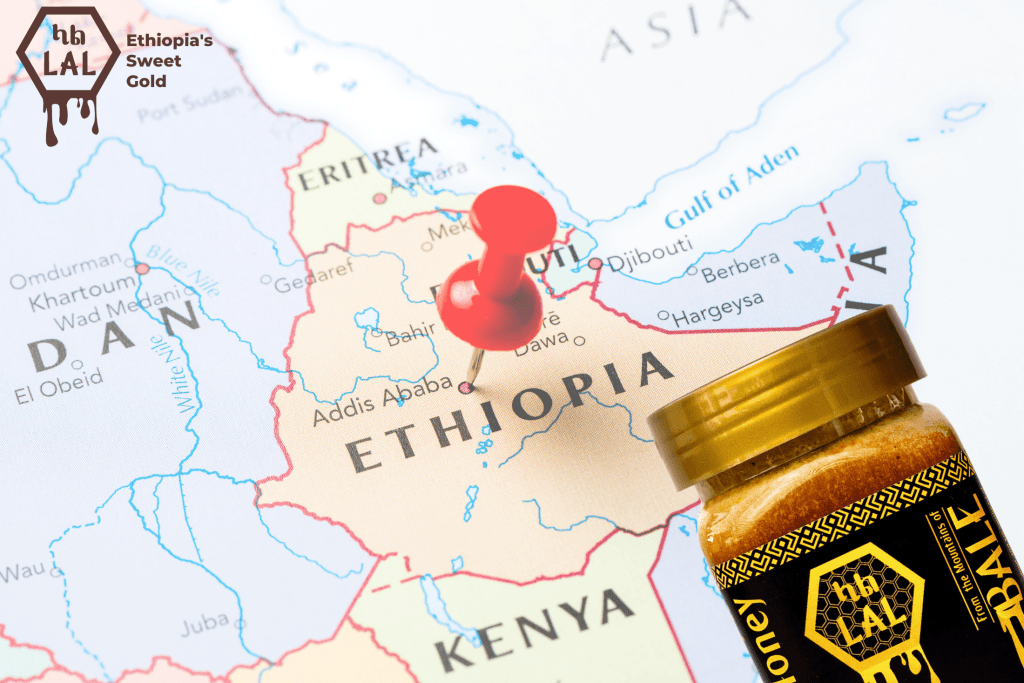
Taste the Uniqueness: Discovering Ethiopian Honey
Ethiopia, a land woven with rich histories and painted with diverse landscapes, harbors a sweet secret that’s been whispered among gastronomy enthusiasts worldwide. This secret? Ethiopian honey. Unlike any other, this honey invites you on a flavorful journey that explores an age-old tradition still veiled in mystery beyond its borders. So, let’s unravel this mystique together and dive into what makes Ethiopian honey a unique culinary treasure, its production tradition, and the mesmerizing taste that sets it apart.
Savoring Ethiopia: Unveiling the World’s Most Unique Honey
Ethiopia’s palette is as diverse as its terrain, and its honey is no exception. This section will take you through the historical roots, geographical influences, and the blend of traditional and modern methods that shape Ethiopian honey’s unique identity.
The Origins of Ethiopian Honey: A Sweet Tradition
The Historical Landscape
Ethiopian beekeeping traces its roots back to ancient times, becoming an integral part of the nation’s cultural fabric. Throughout history, various Ethiopian tribes and communities have engaged in beekeeping practices, viewing honey not only as a food source but also as a symbol of celebration and prosperity. In traditional ceremonies and gatherings, honey holds a sacred place, symbolizing purity and abundance. From the ancient tribes of the Oromo and Amhara to the more recent influences of the Tigrayan and Somali cultures, the tradition of beekeeping has been passed down through generations, preserving its significance in Ethiopian society.
The Geographical Canvas
Ethiopia’s diverse geographical landscape, ranging from highland plateaus to lowland savannas, fosters a rich biodiversity that is reflected in its honey production. Each region of Ethiopia boasts its own distinct climate, flora, and fauna, which directly influence the characteristics of the honey produced there. In the lush highlands of the Simien Mountains, for example, bees gather nectar from an abundance of wildflowers, yielding a honey with delicate floral notes. Meanwhile, in the arid lowlands of the Danakil Depression, bees seek out hardy desert blooms, resulting in a darker, more robust honey. These variations create a tapestry of flavors and textures, making Ethiopian honey truly unique and diverse.
Traditional vs. Modern Methods
While traditional beekeeping methods have been practiced for centuries in Ethiopia, modern techniques are gradually making their mark on the industry. Traditional beekeepers, often belonging to rural communities, continue to utilize age-old methods such as hollow log hives and smoke to harvest honey, maintaining a deep connection to their cultural heritage. However, with advancements in technology and beekeeping practices, modern beekeepers are incorporating innovations such as movable frame hives and protective gear, improving efficiency and honey yield. Despite these advancements, there remains a concerted effort to preserve the authenticity of Ethiopian honey production, ensuring that modernization complements rather than replaces traditional practices. Thus, the Ethiopian honey industry stands at a crossroads, blending the old with the new to sustain a sweet tradition for generations to come.
Palette of Flavors: Understanding Ethiopian Honey Varieties
Here’s where the honey truly becomes a mosaic of flavors, each variety telling a story of its region and the adventures it undertakes from hive to table.
The White Honey of Tigray
Tigray, a region in northern Ethiopia, is renowned for producing a rare and prized delicacy known as white honey. This exquisite honey stands out for its light color and subtle, floral taste, making it a sought-after treat among connoisseurs. The harvest of white honey is steeped in age-old traditions, reflecting the deep cultural significance it holds for the people of Tigray. Beekeepers in the region meticulously tend to their hives, carefully collecting the honey using methods passed down through generations. The rituals surrounding the harvest of white honey serve not only to preserve its purity but also to honor the ancestral connection to the land and its bounty. In Tigrayan culture, white honey holds a special place in ceremonies and celebrations, symbolizing prosperity, purity, and the sweetness of life.
The Richness of Forest Honey
Ethiopia’s vast forests harbor a treasure trove of biodiversity, and this richness is reflected in the diversity of forest honeys found throughout the country. From the misty highlands to the dense lowland jungles, each forest ecosystem contributes its own unique flavors and characteristics to the honey produced there. Highland forest honeys, enriched by the nectar of alpine flowers and herbs, boast a delicate sweetness with hints of mountain herbs. In contrast, lowland forest honeys, gathered from the depths of lush tropical forests, are characterized by their deep, earthy flavors and robust viscosity. The richness of forest honeys not only delights the palate but also offers a glimpse into the intricate tapestry of life within Ethiopia’s diverse ecosystems.
The Wild Honey: A Taste of Adventure
For adventurous honey enthusiasts, Ethiopia’s wild honeys offer a tantalizing taste of the untamed wilderness. Harvested from remote and often perilous locations, such as cliffside hives or deep within dense forests, wild honey embodies the spirit of adventure and exploration. Wild honey hunters, known for their daring exploits, employ a variety of methods to access these hidden treasures. Some rely on traditional techniques passed down through generations, using smoke to calm the bees before carefully extracting the honeycomb. Others embrace more unconventional approaches, scaling sheer cliffs or navigating through dense vegetation in search of elusive hives. Each method brings its own risks and rewards, contributing to the unique flavor profiles and health benefits of wild honey. From the rugged landscapes of the Bale Mountains to the pristine wilderness of the Omo Valley, the quest for wild honey offers an exhilarating journey into the heart of Ethiopia’s natural wonders.
From Hive to Table: The Production Journey
Ever wondered about the bees behind the magic and their journey? Let’s take a peek.
The Life of an Ethiopian Bee
Within the rich tapestry of Ethiopia’s natural landscapes, native bee species thrive, playing a vital role in the country’s honey production. These indigenous bees, including the revered African honeybee (Apis mellifera scutellata), navigate the diverse ecosystems of Ethiopia, from highland meadows to acacia-dotted savannas. The life cycle of an Ethiopian bee is intricately linked to the seasonal rhythms of the environment. As the rainy season arrives, flowers bloom in abundance, providing ample nectar for the bees to collect and store in their hives. During the dry season, when resources become scarce, bees rely on stored honey to sustain their colonies. This harmonious dance between bee and environment shapes the unique cycles of honey production in Ethiopia, resulting in a bounty of flavors and textures that reflect the changing seasons.
Harvesting Traditions
In Ethiopia, the act of harvesting honey transcends mere labor; it is a communal affair steeped in tradition and reverence. Throughout the country, beekeeping communities gather to celebrate the arrival of the honey harvest, marking the occasion with rituals that honor both the bees and the bounty they provide. These rituals vary from region to region but often involve offerings to the spirits of the land and prayers for a bountiful harvest. As the honey is harvested, beekeepers work together in harmony, employing techniques passed down through generations to ensure minimal disruption to the bees and their colonies. The sense of camaraderie and shared purpose during the honey harvest reinforces the importance of community in Ethiopian culture, forging bonds that extend beyond the hive.
Ensuring Purity and Quality
In a rapidly modernizing world, Ethiopian beekeepers remain steadfast in their commitment to preserving the purity and unique flavors of their honey. While modern beekeeping methods have introduced innovations such as movable frame hives and centrifugal honey extractors, traditional practices continue to play a central role in honey production. Beekeepers carefully handcraft their hives from locally sourced materials, such as woven grass or hollow logs, ensuring a natural and sustainable approach to beekeeping. Additionally, stringent quality control measures are implemented to uphold the standards of Ethiopian honey, from hive management to storage and packaging. As consumer demand for organic and ethically sourced products grows, Ethiopian honey producers adapt to meet evolving expectations while staying true to the timeless traditions that define their craft.
Conclusion
As we conclude our exploration of Ethiopian honey, we find ourselves not just at the end of a journey, but at the beginning of a deeper appreciation for this extraordinary culinary treasure. Ethiopia, with its diverse landscapes and rich cultural heritage, offers a honey like no other—a honey steeped in tradition, nurtured by the land, and imbued with the spirit of its people. From the ancient rituals of honey harvesting to the delicate balance between tradition and innovation in production, each aspect of Ethiopian honey tells a story of resilience, community, and a deep connection to the natural world. At Lal The Honey Company, we take pride in sharing this story with the world, offering a taste of Ethiopia’s sweetness and inviting you to join us on a journey of discovery, one spoonful at a time. Let’s savor the richness of Ethiopian honey together, celebrating its past, present, and the promising future it holds for generations to come.

